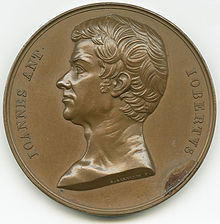
Back Giovanni Antonio Giobert German Giovanni Antonio Giobert Italian Giovanni Antonio Giobert Portuguese
Giovanni Antonio Giobert | |
|---|---|
 IOANNES ANT. IOBERTVS, Medal by Gaspare Galeazzi | |
| Born | 27 October 1761 |
| Died | 14 September 1834 (aged 72) |
| Scientific career | |
| Fields | Chemistry |
| Institutions | University of Turin |
Giovanni Antonio Giobert also known as Jean-Antoine Giobert (27 October 1761 in Mongardino - 14 September 1834 in Millefiori) was an Italian chemist and mineralogist[1] who studied magnetism, galvanism,[2] and agricultural chemistry.[3][1] He introduced Antoine Lavoisier's theories to Italy, and built a phosphorus-based[4] eudiometer sufficiently sensitive to measure atmospheric carbon dioxide and oxygen.[5][6] He identified the correct composition of the mineral Gioberite, a form of magnesite (MgCO3) found in the Piedmont area.[7] He was made a knight (Cavaliere) for his work on the chemistry of indigo dyes.[8]
- ^ a b Abbri, Ferdinando (2001). "GIOBERT, Giovanni Antonio". Dizionario Biografico degli Italiani. 55. Retrieved 15 September 2017.
- ^ Ronalds, Sir Francis (1880). Catalogue of Books and Papers Relating to Electricity. London: E. & F. N. Spon. p. 202. Retrieved 14 September 2017.
- ^ Royal Society of London (1868). Catalogue of Scientific Papers (1800-1863). Vol. II. London: George Edward Eyre & William Spottiswoode. pp. 892–893. Retrieved 15 September 2017.
- ^ Cite error: The named reference
Benedictwas invoked but never defined (see the help page). - ^ "Progress of Manufactures, Science, and the Fine Arts". The Scots Magazine and Edinburgh Literary Miscellany. 67. Archibald Constable & Company: 367. 1805.
- ^ "Galvanism". Encyclopaedia Britannica: Or, A Dictionary of Arts, Sciences, and Miscellaneous Literature, Enlarged and Improved. Vol. 9 (6 ed.). Edinburgh: Archibald Constable & Company. 1823. p. 366.
- ^ Cite error: The named reference
Reeswas invoked but never defined (see the help page). - ^ Cite error: The named reference
Missiagliawas invoked but never defined (see the help page).